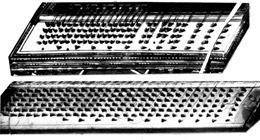click!
![]()
fig. 53a:
Tobias Norlind's
older
construction
![]()
fig.
53a: Tobias
Norlind's
' younger'/newer construction
CHAPTER 3: History to 1800
3.5 The Baroque, Rococo and Classical Periods 1600-1800
3.5.1 The west
1.2. Higher cultures in the 17th & 18th centuries: Romance language-area
Instruments: Characteristics of 17th & 18thC. salterii and psaltérions
[153c]
click! |
Box construction
It is interesting to consider Dr. Norlind's idea here, that the 'box' and 'integral' approaches to contruction are 'older' and 'younger' respectively (fig. 53): the older way was to make a box, and then put the wrest-blocks and hitch-blocks inside that box; the newer way was to add the base and sound-board to the wrest- and hitch-blocks, using them as the sides of the box, an integral part of it.
There are 20 examples of the 'younger' type in the 18th century, and only one of the 'older' type, but there is likewise only one 'older' type in the 17th century while there are six examples of the 'younger' type. So there are altogether 26 examples of the 'new' and only two of the 'old', and we conclude that the characteristic construction of 17th and 18th century salterii and psaltérions was that in which the wrest- and hitch-blocks are an integral part of the soundbox, and form its sides.
click!

fig. 98: 18thC.
wrest-pins, V&A and MHM Stockholm (photos DK)
A corollary to this is that in every surviving instrument, the wrest-pins are mounted in the top of the wrest-block: side mounting was by this time characteristic of instruments in the santur area.
The only exception to this rule is the drawing of Diderot, 1785, which shows side pins; we may perhaps be safe in assuming that the drawing was not accurate in this point. It appears from all examples except one that wrest-pins were universally made out of nails hammered flat at the end, and either filed down the middle to catch the end of the string, or simply left, the string binding on itself after a few turns; in this there was apparently no change since Hutmacher's time (c.l590).
In one example, V&A 273-1882, it seems that nails have been hammered square rather than flat, and the much neater general impression may have pleased its player in an age when eccentricity was perhaps less cultivated than it is today.
|
|